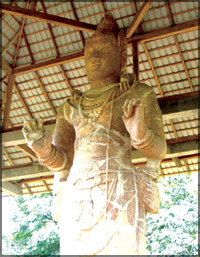 Maligawila
- a reflection of ancient glory Maligawila
- a reflection of ancient glory
Ever
since the arrival of Arahat Mahinda Thera in Sri Lanka during the reign
of King Devanampiyatissa, Buddhist culture has flourished in our
paradise isle.
As a result, hundreds of historical sites
reflecting the splendour of the ancient Buddhist culture are found
scattered all over the country, even now. Foreign as well as local
tourists never fail to be astonished by the breathtaking evidence of ancient Sri Lanka's marvels.
breathtaking evidence of ancient Sri Lanka's marvels.
One such extraordinary historical site is Maligawila.
Maligawila Buddha Statue
Although there are plenty of attractions in Maligawila, it is best
known for its gigantic free-standing Buddha statue, which is said to
belong to the seventh century. It is also considered as the tallest
free-standing Buddha statue of the country, standing up to a height of
14.5 metres.
This monument had been discovered in 1951, in a dilapidated (shabby)
condition, fallen and broken into pieces. Serious efforts were made to
raise this statue in 1974, with little success.
Finally, in the 1980s, the statue was raised and restored and some of
the ruins around it were excavated (dug). The remains around the statue
suggest that there had been an image house surrounding this gigantic
creation. This image house is believed to have had a length and breadth
of eighty feet each.
It is surprising to know that this large statue is carved out of a
single block of limestone weighing about 100 tons. This statue is
believed to have been done by a prince called Aggabodhi, who ruled the 'Rohana'
region of Sri Lanka in the seventh century.
Further proof for this can be found in the Chulavamsa, which has a
verse probably referring to a King Aggabodhika who ruled during the
seventh century. This says that the king built a hospital in 'Kanagama',
which means the 'village of the blind' and that he set up a stone statue
of the Buddha which was called 'The Great', because it was produced as
if by a miracle.
It seems very likely that this refers to Maligawila and its temple,
hospital and statue. Anyway, it is easy to understand how such a huge
and finely sculptured image could earn the name 'The Great'.
It is also believed that Prince Aggabodhi made a single monastery
complex, which had been identified as the Pathma Vihara situated in
Kanagama. It has been mentioned as Ariyakara Vihara in the Mahavamsa.
Later on, King Dappula who also reigned during the seventh century,
constructed an image house to the Buddha statue and a Maitreya
Bodhisattva statue at Dambegoda. It is recorded that he also decorated
the Buddha statue and made offerings.
Avalokitheswara Bodhisattva Statue
The next attraction at Maligawila is another statue carved out of a
rock; this lies about half a kilometre away from the Buddha statue.
from the Buddha statue.
This is thought to be the image of the Avalokitheswara Bodhisattva
and is sometimes also identified as Maithree Natha Bodhisattva statue or
Dambegoda Bodhisattva statue. Avalokitheswara Bodhisattva is believed to
be a heavenly being who chose to reside among humans to help ordinary
people achieve salvation.
The statue weighs about 60 tons and stands 9.85 metres tall. The
statue had been in several pieces at the point of discovery, but
luckily, since the face was lying down, the details of the face had been
preserved.
Unfortunately, after its discovery, vandals had blown up the image
with dynamite, breaking it into over a hundred fragments, believing that
the statue contains treasure. After a long and tiring effort, the image
was finally restored in 1990.
Stone inscription
Just left to the stairway to the Bodhisattva statue lies a pillar
inscription protected by a newly built structure. This stone pillar is said to have been placed by King Mahinda IV
(956-972 AD) on his 10th year of reign.
This stone pillar is said to have been placed by King Mahinda IV
(956-972 AD) on his 10th year of reign.
This inscription records the work done by the king to uplift Buddhism
and has some rules laid down by him regarding the administration of
Buddhist sites.
Aravinda Dassanayake |
